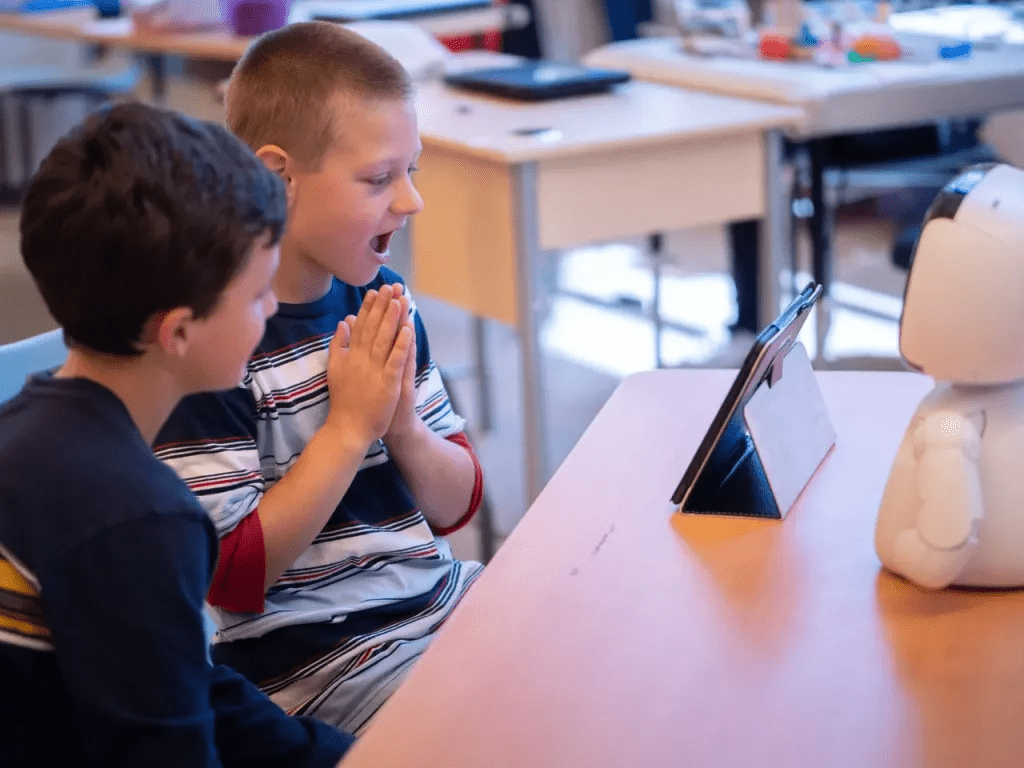In 2020, the Centers for Disease Control and Prevention (CDC) reported that approximately 1 in 54 children is diagnosed with autism in the United States. These children enter the educational system with unique learning styles that need to be considered.
Of course, educators and parents alike want children to learn and grow, both academically and socially.
The good news is that it has been proven that building repetition in children with autism can boost their learning capacity. Interactive robots are a perfect vehicle for this method. Robots can teach children with autism in a way that is repetitive and predictable, which allows for repeated practice, and ultimately boosts their academic success.
The Importance of Repetition in Academics
Neurodiverse students (students with autism and other neurological differences) and neurotypical students are both alike in that they benefit from repeated exposure and practice; repetition solidifies learned concepts. Educators build repetitive practice when they teach new concepts. Nowadays, multiplication concepts are not simply taught rotely, through multiplication tables and memorization, but students have multiple exposures using manipulative tools, charts, visual aids, partner games, algorithms and so on. With time, repetition, and multiple exposures children learn and understand multiplication concepts. In this sense, children with autism are the same as their peers.
In a research paper penned by multiple pioneers in autistic learning, a study shows that “students with autism spectrum disorders may require more time and repetition to learn a new skill or concept and incorporate it into their existing repertoire.”
The solution can be found simply in allowing more time to build repetition routines to help them reinforce learned skills to their existing repertoire.
Educators can supplement their teaching with interactive robots that can engage in systematic practice of concepts they are exposed to in the classroom.
Consistent Positive Reinforcement Works Wonders
Consistent positive reinforcement empowers young learners and focuses on encouragement and acknowledgement. Providing necessary amounts of positive reinforcement can be draining and difficult for educators, especially with multiple children in a learning environment. Interactive robots can be a significant help in this capacity.
These robots provide consistent positive reinforcement that can adapt to individual needs without tiring. The added benefit is that children with autism often respond more to robots than humans. Interactive robots are the perfect vehicle to guide enhanced assisted learning. Robots for kids with autism can open up new pathways to learning and reinforce daily living skills, academics, and social emotional learning.
Learning in a Safe Environment
Educators and parents both have a common goal in ensuring that their children receive balanced learning in a safe environment. Interactive robots can produce a safe and non-judgmental environment for children with autism.
Through positive reinforcement and repetition children learn new concepts without struggling to navigate subtle nuances in human-human interactions.
Not only do robots provide a “cool factor” for young children, but they also appropriately respond to all children with special needs in a universal language they can understand.
Changes in Behavior in the Presence of Robots
Four main behaviors are associated with autism:
1. Difficulty in communication
2. Difficulty in social interactions
3. Obsessive interests, such as drawing
4. Repetitive behaviors
Obsessive interests and repetitive behaviors are not necessarily maladaptive and should be encouraged as they are unique to that child’s personality. However, challenges in communication and social interactions can impact social relationships and acceptance by other children.
Interactive robots can help children with autism improve interpersonal skills so they can have positive interactions with others.
RAI: the Solution to Mastering Academics
Ultimately, RAI is an effective learning mechanism for children diagnosed with autism. Robot-Assisted Instruction (RAI) is key in helping children with autism master academics and continually evolve into productive members of society. There are significant benefits in employing this alternative, which include:
· Universal Acceptance – kids love robots and are more willing to accept them as trusted companions.
· No Judgment – Robots aren’t judgmental and use speech that is monotone and easy for children with varying abilities to understand.
· Efficiency – Robots don’t get tired and can provide as much wait time, repetition, breaks, extra praise and patience as needed per child.
· Consistent Learning – Robots can help reinforce concepts through repetition, providing encouragement and promoting perseverance.
· Predictability – RAI is designed to be predictable in the way lessons are introduced and practiced. This provides a sense of predictability the child can feel comfortable with and expect.
Learn More About RAI
Autism awareness is growing in the United States. Parents rely on educators to use innovative approaches to help their kids succeed and master the same academics as other children.
In turn, educators need to adopt widespread effective techniques for making this outcome possible. At MOVIA, we take pride in providing exceptional RAI for educators and families. If you’d like to learn more about the benefits this innovation offers, click here for more information.

